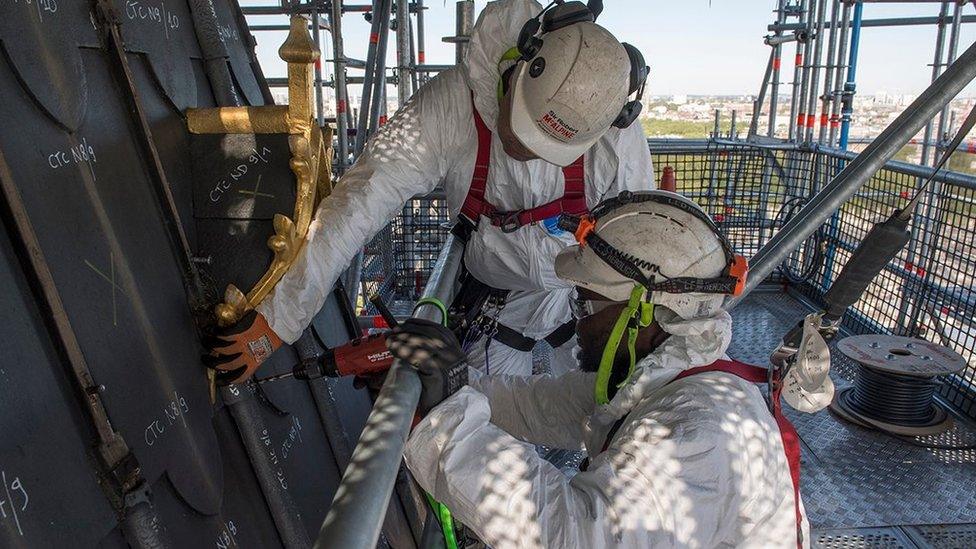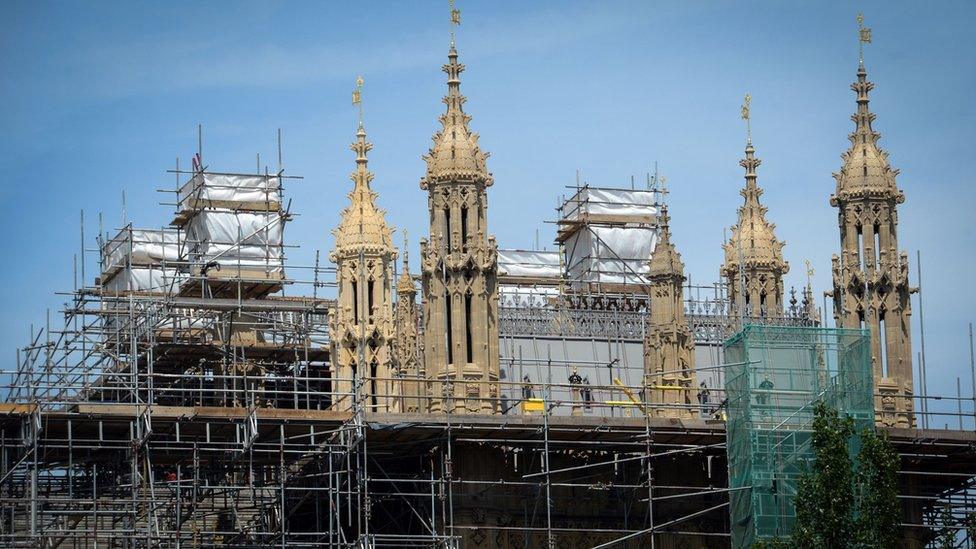Rumbling concern over Parliament's buildings
- Published

"We're less worried about a fire, right now, because there's so much flooding in the building," quipped one parliamentary figure this week, as the leaky roofs and rotting window frames of the Palace of Westminster failed to keep out the autumn weather.
A newly-published survey of the iconic building found thousands of issues, including cracks in stonework, widespread water damage, original Victorian stained-glass windows which are warping and sagging due to age, and cracking ceilings.
Then there's the tangle of pipes and cables and steam lines in the vast basement, which any refurbishment would have to deal with.
All this is no surprise.
The state of Parliament's buildings has been a rumbling concern for more than a decade - but the multi-billion pound price tag for what's called "Restoration and Renewal" has paralysed decision-makers.
It's never a good look to spend billions on MPs' and peers' place of work (the latest guestimate is £12bn, but the Restoration and Renewal Team say they have made no definitive costing).
Beyond that, there's the deep reluctance of many parliamentarians to move out of the buildings in which they have made law for 500 years, to make way for the repair work.
Moving MPs and peers out is a critical issue. It is far quicker and cheaper to do the work if the parliamentarians are not in the way - leaving aside safety concerns about exposure to asbestos.
But secure alternative venues and office space would be needed for the so-called "full decant" option. There is an argument that the virtual proceedings seen during the pandemic may provide an alternative approach, but that looks rather hazy at the moment, and no-one thinks that Parliament is nearly as effective when it operates online.
Meanwhile, the cost of a make-do-and-mend strategy is escalating.

The Public Accounts Committee, external found delay due to maintenance cost £2m per week, and then there's the expense of the 24 hour fire patrol (although the installation of new fire doors has provided some reassurance).
Worse, the deterioration of the building is accelerating despite all the patching-up. The fire which consumed Notre Dame in Paris was a reminder that even the most iconic buildings can burn down, and briefly injected a sense of urgency into thinking about R&R, but that has now faded.
"It's purely a matter of luck that there has not been a major fire or other disaster before now," says Dr Alexandra Meakin of Leeds University, an expert on the Restoration and Renewal saga.
Former Leader of the Commons David Lidington tweeted that if Parliament were a normal place of work it would have been closed on health and safety grounds, by now.
Given the price tag, a decision on what to do rests with the government. The next step, pushed back to 2023, will be a vote on the "Outline Business Case" for moving out. The Commons voted in favour of the "full decant" back in 2018, but there is now some back-pedalling - and a plan for a temporary Commons Chamber in Richmond House, the old Department of Health HQ in Whitehall has been dropped, with £70.2m spent on the project written off this year by the House of Commons.
Ministers, unsurprisingly, are determined not to appear to be splashing the taxpayers' cash on their own comforts, especially when the decision day could be uncomfortably close to the next general election.
In fact, Dr Meakin believes that the political support for Restoration and Renewal is now lower than it has been for a decade, with the Leader of the Commons Jacob Rees-Mogg, and the Speaker, Sir Lindsay Hoyle, both known to be unhappy about moving out.
Mr Rees-Mogg says Parliament "must be able to justify this project to taxpayers".

He adds: "That's why it's so important to understand and map out the restoration work needed to protect the building - so that the focus is on those essential works necessary to preserve the Palace for future generations."
In other words, he is opposed to works which go beyond the minimum necessary - but that minimum is still an enormous sum; there is masonry falling off the building, the wiring and sewage systems need to be revamped and much delicate restoration of historic fixtures and fittings is required.
It may be that the survey findings will prod Parliament's decision makers into action, but it now seems unlikely that work could begin before 2025, which leaves plenty of time for disaster to strike.
If one of the most recognisable buildings on the planet burns down, of floods, or blows a fuse in the middle of a State Opening, it will not be because the parliamentarians were not warned.
- Published24 October 2017

- Published10 March 2017

- Published3 March 2015

